But first: today’s quiz. Not all inventions are cold and scientific… some are more on the “delicious” side of the scale. And some inventors don’t even have to create a particular invention, yet can still be the reason behind its fame. Such is the case with the answer to today’s quiz.
John Montagu, born on this day in 1718, was a well-known British politician, inventor, and explorer. What tasty, well-known invention (which he is the namesake of) -- did he make famous?
On to other historic happenings:
EVENTS
1664
Robert Hooke presents Micrographia
In 1664, Robert Hooke showed an advanced copy of his classic book "Micrographia, or Some Physiological Descriptions of Minute Bodies made by Magnifying Glasses with Observations and Inquiries Thereupon" to the Royal Society in London. This large volume contained sketches of practically everything Hooke could view with the latest invention of the day, the microscope.


Hooke's microscope, and his drawing of a flea as observed through the microscope.
Hooke most famously describes a fly's eye and a plant "cell" (he was the first to coin the term "cell" because plant cells, which are walled, reminded him of a monk's quarters). Known for its spectacular copperplate engravings of the miniature world, particularly its fold-out plates of insects -- the text itself reinforced the tremendous power of the new microscope. The plates of insects folded out to be larger than the large folio itself; the engraving of the louse in particular folding out to four times the size of the book. Also included in the volume were many snow crystal drawings, which for the first time revealed the complexity and intricate symmetry of snow crystal structure
Although the book is most known for foregrounding the power of the microscope, Micrographia also described distant planetary bodies, the wave theory of light, the organic origin of fossils, and various other philosophical and scientific interests of its author.
The book was published in 1665 and promptly became a best-seller.
1892
First Automated Telephone Exchange
In 1892, the first automatic telephone exchange, using the switching device invented by Almon B. Strowger, opened to the public in LaPorte, Indiana, with about seventy-five subscribers.
Almon B. Strowger was an undertaker in Kansas City. According to history, there was a competing undertaker locally whose wife was an operator at the local (manual) telephone exchange. Whenever a caller asked to be put through to Strowger, calls were deliberately put through to his competitor. This obviously frustrated Strowger greatly and he set about devising a system for doing away with the human part of the equation.
Strowger developed a system of automatic switching using an electromechanical switch based around electromagnets and pawls. With the help of his nephew he produced a working model in 1888 (US Patent No. 447918 10/6/1891). In this selector, a moving wiper (with contacts on the end) moved up to and around a bank of many other contacts, making a connection with any one of them.
A selector starts in the 'home' position and with each 'impulse' the wiper contacts would progress round the output bank to the next position. Each output would be connected to a different subscriber, thus the caller could connect to any other subscriber who was connected to that bank, without any manual assistance from an operator.
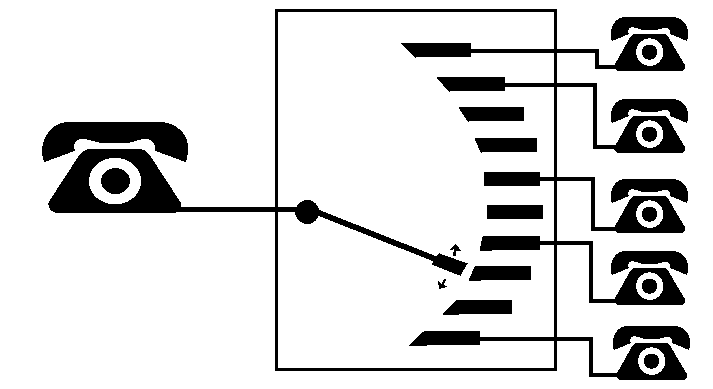
In the figure above, the selector has 10 outputs, so a caller can choose to connect to any of 10 different subscribers by dialing any digit from 1 to 0 (0=10). This sort of automatic selector is known as a Uniselector, as it moves in just one plane (rotary).
By mounting several arcs of outlets on top of each other, the number of outlets can be increased significantly but the wipers are then required to move both horizontally to select a bank and then vertically to move around that bank to the required outlet. Such a selector is known as a Two-Motion Selector. Two-motion selectors typically have 10 rows of 10 outlets, thus 100 possible outlets altogether. A two-motion selector can therefore accept two dialed digits from a subscriber and route the call to any of 100 numbers. The selector 'wipers' always start in their resting 'home' position. The first digit moves the selector vertically up to the corresponding level and then the second digit moves the wipers around the contacts of that level. This is shown in the figure below.
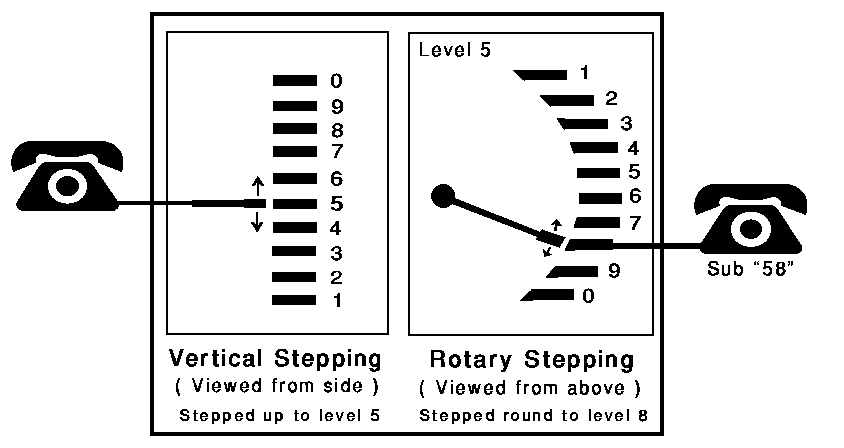
Strowger did not invent the idea of automatic switching; it was first invented in 1879 by Connolly&McTigthe but Strowger was the first to put it to effective use. Together with Joseph B. Harris and Moses A. Meyer, Strowger formed his company 'Strowger Automatic Telephone Exchange' in October 1891.
http://www.seg.co.uk/telecomm/automat1.htm
1900
The nation’s first car show was held in Madison Square Garden, New York City. Fifty-one exhibitors attended at the week-long exposition, which included hill-climbing, steering, and braking contests.
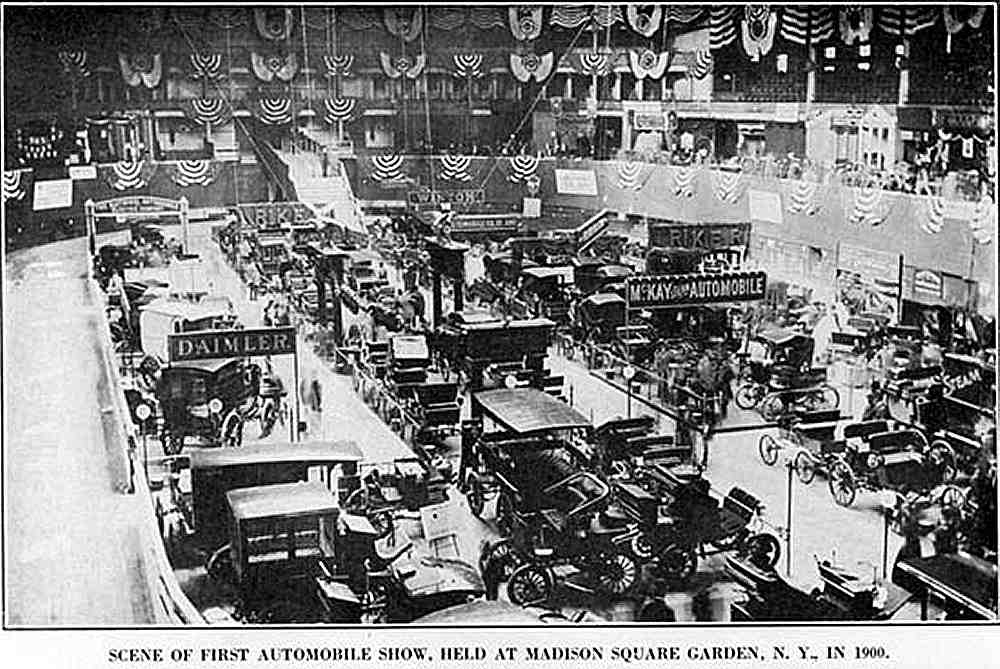
1925
“Quick Frozen” Foods First Introduced
In 1925, Clarence Birdseye marketed the first quick frozen fish. He left school and entered into the fur-trading business in 1912, and found himself on the Peninsula of Labrador in Canada for the next five years. It was in Labrador that Birdseye made the simple discovery that would revolutionize the frozen food industry: poultry, seafood, and meats frozen in the bitter cold of the arctic winter tasted better than those frozen in spring and fall's milder temperatures. The process that Birdseye watched the Inuit use in the early 1900s later became known as the process of quick freezing. Quick freezing is the process through which items are frozen at such a speed that only small ice crystals are able to form. The cell walls are not damaged, and the frozen food, when thawed, keeps its maximum flavor, texture, and color.

Back in the United States again, the inventive Birdseye refined and perfected a machine called a "Quick Freeze Machine" that he unveiled in 1925. Despite the revolutionary improvements that Clarence Birdseye made to the quality of frozen foods, he could not overcome the public’s general distrust of frozen foods based on their experiences with previously available frozen products.
Furthermore, the costs of building and maintaining machinery caused Birdseye and his frozen foods considerable distress. Though not widely embraced, Birdseye's foundation of the General Seafoods Company would make him a wealthy man. In 1929, the "Father of Frozen Food" sold his company to the Postum Company. From this point on, the General Seafoods Company would be known as the General Foods Corporation. As a result of the Postum Company's purchase of Birdseye's Seafoods Company, the Birdseye name was kept a part of the company trademark, though it was split into two words: Birds Eye.
http://www.otal.umd.edu/~vg/amst205.F97/vj30/project5.html
1957
Sputnik 2 Launched
After the surprise public impact of Sputnik 1, the satellite and launch teams were called back from vacation and in one month assembled Sputnik 2 (using equipment already developed for dog sounding rocket flights). The spacecraft, which remained attached to the upper stage, carried the dog Laika. No recovery was possible, and the dog perished in orbit due to higher-than-expected temperatures.
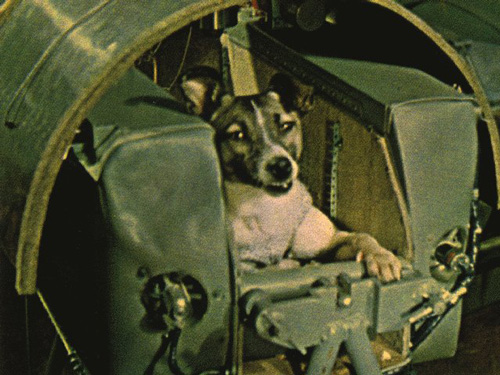
The life-support system and the consumables were designed for a 7-day flight. Control of the internal atmosphere was provided by a carbon dioxide absorbing device, an oxygen generator, an oxygen regulator, and a fan that activated when the cabin temperature went above 15 deg C. Food and water were ejected by tube directly into the stomach in jelly form, and wastes were removed by another implanted tube. Restraints kept Laika from moving far -- she could not even turn around. Her electrocardiogram and data on respiration rate and maximum arterial pressure, were radioed to the ground when over the Soviet Union. A crude television monitor allowed her movements in the cabin to be seen.
Three dogs -- Albina, Laika and Mushka -- were involved in flight preparations. Albina was the back-up dog, and had survived earlier sounding rocket flights into space. Mushka was the stand-in for tests. All the dogs had been trained to survive in small cages in preparation for the flight. Laika was sealed into her cramped cabin four days before launch.
Despite her ordeal on the ground she survived the launch and her heart rate returned to normal after a time. She had proven that an animal could survive in sustained spaceflight. But in practice the environmental control system was not up to the task. Telemetry showed that temperature and humidity increased relentlessly. By the fourth orbit none of the physiological sensors were returning data -- Laika had evidently died. This fact was not revealed until the 21st Century.
http://www.astronautix.com/craft/sputnik2.htm
BIRTHS
1854
Jokichi Takamine (Born: Nov 3 1854; Died: Jul 22 1922)
Jokichi Takamine was a biochemist who was the first to isolate and purify a hormone from a natural source.
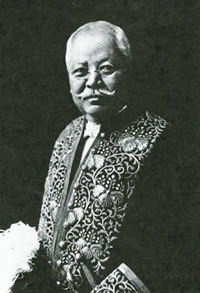 Takamine isolated the hormone produced in the adrenal gland that causes the body to respond to emergencies – adrenalin.
Takamine isolated the hormone produced in the adrenal gland that causes the body to respond to emergencies – adrenalin.Although born in Japan, Takamine spent most of his adult life in the United States. His success in isolating adrenalin was a surprise to the scientific community, especially because his competition included such better known figures as John Jacob Abel of Johns Hopkins University and Otto von Furth of Strasburg, Germany (now France).
In 1895, George Oliver and Edward Schäfer had discovered that when the secretions of adrenal glands were extracted and injected into an experimental animal, they could raise blood pressure. The purification of this principle became a matter of interest, and in 1897, John Jacob Abel and Albert C. Crawford thought that they had succeeded when they purified a crystalline principle they named epinephrine. (It was later shown that they had isolated a benzoyl derivative rather than the pure hormone.)
Takamine followed up on their epinephrine work, and sometime in 1900 he visited Abel’s laboratory at Johns Hopkins, where he was welcomed and shown full scientific courtesy. Takamine followed Abel’s methods for removing fat and protein, partitioning his concentrated extract with acidified water, and then precipitating the active principle with ammonia. It was Takamine’s assistant, working alone one night, who first obtained a crystalline product -- but it was Takamine who filed a patent application on November 5, 1900, titled “Glandular Extractive Product” on a blood-pressure-raising principle he called adrenalin.
Within a few months, Takamine presented two papers, one before the Society of Chemical Industry and another before the New York State Medical Society. That same year (1901), he published two single-author papers in the scientific literature and applied for and was awarded the right to use the word Adrenalin as a trademark. Simultaneously, a colleague at Parke, Davis, Thomas Aldrich, published the correct chemical structure, and the company began marketing the product under the trade name Adrenalin.
The discovery of adrenalin was a medical and popular sensation. Physicians carried it in their bags, and it is said that Gene Tunney, the champion boxer, always kept some on hand when he went into the ring. The drug transformed surgery, where it was used to control hemorrhage. Adrenalin also found uses in cardiology, obstetrics, and the treatment of asthma and other allergies. It was widely prescribed for several conditions for which it was useless, including goiter, deafness, and Addison’s disease. The emperor of Japan acknowledged Takamine’s feat by conferring the Order of the Rising Sun, Fourth Class. He also sent 15 imperial cherry trees to Parke, Davis, where they were planted in front of the administrative offices.
John Jacob Abel felt scooped and duped. Although he accepted the fact that that Takamine had isolated a crystalline product, he persisted in the belief that the product was not pure and that the chemical formula proposed by Aldrich and Takamine was not correct. Gradually, the term “adrenalin” fell out of the scientific literature and was replaced with “epinephrine”. But adrenalin was the word adopted in ordinary language. People commonly talked about having “an adrenalin rush” or “getting their adrenalin up”.
Although Abel was wrong about the chemical structure of epinephrine, his assertion that Takamine’s adrenalin was impure was shown to be correct in a way that he did not anticipate, nor could he have demonstrated, given the chemistry of the time. The contaminant was norepinephrine. The early 20th-century product sold by Parke, Davis under the trade name Adrenalin was actually a mixture of epinephrine and norepinephrine.
As Takamine became wealthier, he left his laboratory work behind and turned his energies toward improving the position of the Japanese in the United States. He helped found the Nippon Club and the Japan Society to foster better relations between Americans and the Japanese. When Takamine learned in 1909 that First Lady Helen Herron Taft was working to beautify the Tidal Basin area around the Potomac River in Washington, DC, he funded a gift of 2000 cherry trees from the mayor of Tokyo to the city of Washington. This symbol of Japanese–American friendship has become a clichéd tourist attraction, but almost no one remembers the man who was instrumental in making it happen.

http://pubs.acs.org/subscribe/journals/mdd/v04/i12/html/12timeline.html
1872
Wilfred Trotter (Born: Nov 3 1872; Died: Nov 25 1939)
Trotter was a British surgeon, who was an authority on cancers of the neck and head and recognized as a pioneer in neurosurgery. He was also known for his studies on social psychology, most notably for his concept of the “herd instinct”, which he first outlined in two published papers in 1908, and later in his famous popular work Instincts of the Herd in Peace and War.

Originally published in 1919, this classic work of social psychology introduced the concept of the herd instinct in relation to human behavior and explored the fundamental importance of gregariousness among animals as well as among humans. Trotter argued that gregariousness was an instinct, and studied beehives, flocks of sheep and wolf packs. He related how herd membership created a homogeneity whereby individuals would instead act together as one.
Large stock market trends often begin and end with periods of frenzied buying (bubbles) or selling (crashes). Many observers cite these episodes as clear examples of herding behavior that is irrational and driven by emotion -- greed in the bubbles, fear in the crashes. Individual investors join the crowd of others in a rush to get in or out of the market.
Trotter met Sigmund Freud several times. According to Ernest Jones (Freud's first biographer), "he was one of the first two or three in England to appreciate the significance of Freud's work.” Working at University College Hospital in London, as professor of surgery, Trotter held the office of honorary surgeon to King George V from 1928 to 1932. He was also a member of the Council of the Royal Society that conferred their Honorary Membership on Professor Freud, whom he attended after his move to England. Later he was consulted about Freud's terminal cancer, in 1938.
1897
Frederick Stratten Russell (Born: Nov 3 1897; Died: Jun 5 1984)
Russell was an English marine biologist who linked the depth distribution of planktonic organisms to the intensity of light in the seas off the British Isles. He used photoelectric cells to measure the light, finding that the plankton moved up and down the water column in a daily cycle. Seasonal variations in light intensity also affected the migrations. His work helped explain the long-term changes in the ecosystem of the English Channel.
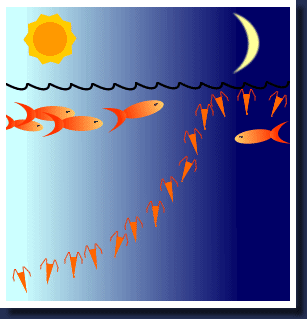
During World War I he was an aerial observer and the photographs he took while suspended beneath the fuselage of the aircraft at a height of 18-20,000 feet are among the more famous of the 1st World War.
At Cambridge after the war he developed an interest in marine biology, and worked in Egypt for two years, before returning to the Marine Biological Association Laboratory at Plymouth in 1924. During World War II Russell joined RAF intelligence where he successfully constructing evidence of enemy bombing strategy. Despite many offers of academic jobs, Russell preferred after the War to stay at the Plymouth Laboratory.
Russell's technical knowledge of seafaring, commercial fishery, photography and minesweeping as well as statistics and his experimental skills enabled him to investigate the complex interplay of temperature, depth, light, sea currents, diurnal variation, life and breeding cycles and the distribution of plankton. His studies enabled him to draw up a plankton map of the UK waters - an invaluable tool in fishing policy. He also pioneered the measurements of fish stocks that made possible the control of over-fishing by quotas. Russell's other field of research was the life cycle and taxonomy of medusae (jellyfish), on which he published several books.
Russell was knighted in 1965.
http://www.nahste.ac.uk/isaar/GB_0237_NAHSTE_P1869.html
And the answer to today’s quiz?
What well-known, tasty snack did John Montagu make famous? Montagu, the 4th Earl of Sandwich, was an 18th-century English aristocrat. Although he was not the inventor of the food, it is said that Lord Sandwich was fond of this particular form of food because it allowed him to continue playing cards while eating, yet prevented him from getting his cards greasy from eating meat with his bare hands. So he frequently told his servants to bring him meat between two slices of bread -- which of course is known today as, the sandwich.







Comments